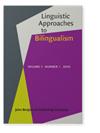调节初始L3迁移全局相似性的因素
IF 1.8
2区 文学
0 LANGUAGE & LINGUISTICS
引用次数: 2
摘要
许多关于第三语言习得的正式语言学研究都集中在迁移源的选择上,总体发现L1/L2和L3之间的(整体)结构相似性是初始迁移模式的最强预测因子。最近,Cabrelli和Pichan(2021)报告了三级巴西葡萄牙语(BP)和三级意大利语中潜在的间隔性浊音顿音产生的数据,强调了全球相似性可能受到其他因素调节的概念。具体来说,来自传统西班牙语/英语双语者学习L3 BP的数据反映了对(非促进性的,但在全球范围内更相似)西班牙语的依赖,而L3意大利语数据反映了对(促进性的,但在全球范围内不太相似)英语的更大依赖。目前的研究是确定差异来源的第一步,我们研究了传统西班牙语/英语双语者的主导程度和显性知识的作用。34名L3级意大利语学习者完成了三种语言的延迟重复任务。我们报告了与L3 BP数据相矛盾的英语样模式,不能用显性知识或显性知识来解释。我们将这些结果与现有的三语传输账户联系起来,并进一步考虑语言和方法变量的必要性,特别是三语输入和任务模式中的声学显著性。本文章由计算机程序翻译,如有差异,请以英文原文为准。
Factors that moderate global similarity in initial L3 transfer
Much of the formal linguistic research on third language (L3) acquisition has focused on transfer source
selection, with the overall finding that (global) structural similarity between the L1/L2 and L3 is the strongest predictor of
initial transfer patterns. Recently, Cabrelli and Pichan (2021) reported data from the production of underlyingly intervocalic
voiced stops in L3 Brazilian Portuguese (BP) and L3 Italian that highlight the notion that global similarity is likely moderated
by other factors. Specifically, data from heritage Spanish/English bilinguals learning L3 BP reflected reliance on
(non-facilitative, but globally more similar) Spanish, while L3 Italian data reflected greater reliance on (facilitative, but
globally less similar) English. The current study is a first step towards identifying the source(s) of the disparity, in which we
examine the roles of degree of dominance and explicit knowledge in heritage Spanish/English bilinguals. Thirty-four L3 Italian
learners completed a delayed repetition task in all three languages. We report English-like patterns that contradict the L3 BP
data and cannot be accounted for by degree of dominance or explicit knowledge. We connect these results to existing L3 transfer
accounts and the need for further consideration of linguistic and methodological variables, particularly acoustic salience in L3
input and task modality.
求助全文
通过发布文献求助,成功后即可免费获取论文全文。
去求助
来源期刊

Linguistic Approaches To Bilingualism
Social Sciences-Linguistics and Language
CiteScore
3.20
自引率
9.10%
发文量
24
期刊介绍:
LAB provides an outlet for cutting-edge, contemporary studies on bilingualism. LAB assumes a broad definition of bilingualism, including: adult L2 acquisition, simultaneous child bilingualism, child L2 acquisition, adult heritage speaker competence, L1 attrition in L2/Ln environments, and adult L3/Ln acquisition. LAB solicits high quality articles of original research assuming any cognitive science approach to understanding the mental representation of bilingual language competence and performance, including cognitive linguistics, emergentism/connectionism, generative theories, psycholinguistic and processing accounts, and covering typical and atypical populations.
 求助内容:
求助内容: 应助结果提醒方式:
应助结果提醒方式:


